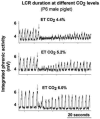Laryngeal reflex apnea in neonates: effects of CO2 and the complex influence of hypoxia
- PMID: 23348024
- PMCID: PMC3604991
- DOI: 10.1016/j.resp.2013.01.004
Laryngeal reflex apnea in neonates: effects of CO2 and the complex influence of hypoxia
Abstract
We have examined influence of hypocapnia, mild hypercapnia and hypoxia on the durations of fictive apnea and respiratory disruption elicited by injection of 0.1ml of water into the laryngeal lumen-the laryngeal chemoreflex (LCR)-in 20 unanesthetized, decerebrate, vagotomized piglets aged 4-10 days that were paralyzed and ventilated with a constant frequency and tidal volume. The LCR was enhanced by hypocapnia and attenuated by hypercapnia as reported by others. The responses to laryngeal stimulation during hypoxia were varied and complex: some animals showed abbreviated responses during the tachypnea of early hypoxia, followed after 10-15min by more prolonged apnea and respiratory disruption accompanying the reduction in ventilatory activity that commonly occurs during sustained hypoxia in neonates. We speculate that this later hypoxic enhancement of the LCR may be due to accumulation of adenosine in the brain stem.
Copyright © 2013 Elsevier B.V. All rights reserved.
Figures


Similar articles
-
Prolonged hypoxemia enhances and acute hypoxemia attenuates laryngeal reflex apnea in young lambs.Pediatr Res. 1993 Dec;34(6):813-20. doi: 10.1203/00006450-199312000-00024. Pediatr Res. 1993. PMID: 8108200
-
Fatal apnea in piglets by way of laryngeal chemoreflex: postmortem findings as anatomic correlates of sudden infant death syndrome in the human infant.Laryngoscope. 2005 Jul;115(7):1163-9. doi: 10.1097/01.MLG.0000165458.52991.1B. Laryngoscope. 2005. PMID: 15995501
-
Unilateral microdialysis of gabazine in the dorsal medulla reverses thermal prolongation of the laryngeal chemoreflex in decerebrate piglets.J Appl Physiol (1985). 2007 Nov;103(5):1864-72. doi: 10.1152/japplphysiol.00524.2007. Epub 2007 Sep 6. J Appl Physiol (1985). 2007. PMID: 17823299
-
Control of breathing in the newborn.Ann Biomed Eng. 1981;9(5-6):425-37. doi: 10.1007/BF02364761. Ann Biomed Eng. 1981. PMID: 6814308 Review. No abstract available.
-
Reflux associated apnea in infants: evidence for a laryngeal chemoreflex.Am J Med. 1997 Nov 24;103(5A):120S-124S. doi: 10.1016/s0002-9343(97)00336-7. Am J Med. 1997. PMID: 9422636 Review.
Cited by
-
Sex-Specific Consequences of Neonatal Stress on Cardio-Respiratory Inhibition Following Laryngeal Stimulation in Rat Pups.eNeuro. 2018 Jan 4;4(6):ENEURO.0393-17.2017. doi: 10.1523/ENEURO.0393-17.2017. eCollection 2017 Nov-Dec. eNeuro. 2018. PMID: 29308430 Free PMC article.
-
Utilizing multimodal imaging to visualize potential mechanism for sudden death in epilepsy.Epilepsy Behav. 2021 Sep;122:108124. doi: 10.1016/j.yebeh.2021.108124. Epub 2021 Jul 5. Epilepsy Behav. 2021. PMID: 34237676 Free PMC article.
-
Prenatal nicotinic exposure prolongs superior laryngeal C-fiber-mediated apnea and bradycardia through enhancing neuronal TRPV1 expression and excitation.FASEB J. 2017 Oct;31(10):4325-4334. doi: 10.1096/fj.201700163R. Epub 2017 Jun 14. FASEB J. 2017. PMID: 28615326 Free PMC article.
-
Laryngeal Chemoreflex in Health and Disease: A Review.Chem Senses. 2020 Dec 5;45(9):823-831. doi: 10.1093/chemse/bjaa069. Chem Senses. 2020. PMID: 33247587 Free PMC article. Review.
-
Ictal activation of oxygen-conserving reflexes as a mechanism for sudden death in epilepsy.Epilepsia. 2021 Mar;62(3):752-764. doi: 10.1111/epi.16831. Epub 2021 Feb 11. Epilepsia. 2021. PMID: 33570173 Free PMC article.
References
-
- Bartlett D., Jr Respiratory functions of the larynx. Physiol Rev. 1989;69:33–57. - PubMed
-
- Bissonnette JM. Mechanisms regulating hypoxic respiratory depression during fetal and postnatal life. Am J Physiol Regu Integr Comp Physiol. 2000;278:R1391–R1400. - PubMed
-
- Bongianni F, Fontana GA, Mutolo D, Pantaleo T. Effects of central chemical drive on poststimulatory respiratory depression of laryngeal origin in the adult cat. Brain Research Bull. 1996;39:267–273. - PubMed
-
- Cohen G, Malcolm G, Henderson-Smart D. Ventilatory response of the newborn infant to mild hypoxia. Peadiatr Pulmonol. 1997;24:163–172. - PubMed
-
- Curran AK, Chen G, Darnall RA, Filiano JJ, Li A, Nattie EE. Lesion or muscimol in the rostral ventral medulla reduces ventilator output and the CO2 response in decerebrate piglets. Respir Physiol. 2000;123:23–37. - PubMed
Publication types
MeSH terms
Substances
Grants and funding
LinkOut - more resources
Full Text Sources
Other Literature Sources

